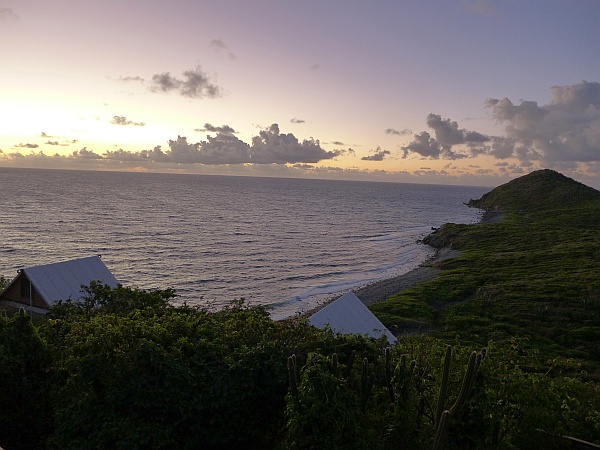
When I visited St. John, U.S. Virgin Islands with Keystone Trails Association last week, I expected it to be different from Pittsburgh but I was surprised at how different it is from North America’s Atlantic coast.
The Virgin Islands are mountainous like Acadia National Park or the Canadian Maritimes, but they’re steeper and their peaks are sharp because they were never scraped by glaciers.

Here’s how steep it was: I climbed 135 steps from our Concordia Eco-Resort cabin to the upper parking area where this photo was taken. By Day Two the drivers in our group always fetched the cars and picked us up at the flat end of the boardwalk below. Whew!

The climate is both dry and humid with a daily high of 81 degrees F in late January. The tops of the mountains are moist and forested. The lower elevations resemble southern California with cacti and succulent plants. Here’s a view at Salt Pond where the water is saltier than the ocean.

81 degrees F sounds comfortable but the dewpoint is always 70+ degrees so it felt hot as soon as the sun came up. Because I don’t like heat, my favorite time of day was dawn and my favorite things were:
- The wind. Unlike North America’s prevailing west wind, the Virgin Islands have a strong east wind — the Trade Winds that brought Europeans to the West Indies.
- The sound of the breakers at Drunk Bay. Our cabin was perched high above boulder-strewn Drunk Bay where the sound of the breakers lulled me to sleep.
- The views. The islands are spectacularly beautiful with steep green mountain peaks and turquoise water. My photos don’t do it justice.
And there are beautiful white sand beaches. Trunk Bay, below, is rated one of the top 10 beaches in the world.

Most amazing of all were these differences in bird life. At St. John I found …
- No flying flocks. I was amazed not to see any flocks in flight.
- No gulls at all. According to a local birder, the laughing gulls return in April but that’s about it.
- Few fishing birds. Magnificent frigatebirds were most numerous (I saw five at once, soaring up from their roost), followed by royal terns (three) and brown pelicans (two).
- Few shorebirds. Except for resident black-necked stilts at Francis Bay there were only single shorebirds at most locations.
- No corvids. No ravens, no crows, no jays.
- No vultures. They sorely needed vultures but this niche seemed to be filled by rats, feral cats and mongooses all of whom were imported to the island.
- Few birds of prey. I saw one red-tailed hawk and a few American kestrels.
Eventually this all made sense. The lack of fishing birds matched the lack of fishing boats. I suppose there are few catchable fish at St. John. Perhaps the coral reefs protect them.
If you like heat and sun and warm Caribbean water you will love St. John, USVI. It’s a very different place from Pennsylvania.
(photos by Kate St. John)
You saw no gulls but I saw gulls in the Walmart parking lot in the Point at North Fayette while shopping this weekend….a flock of at least 50, and maybe more. I thought it was odd for them to be so far from water. I assume they’ve come south because the northern water is freezing over.